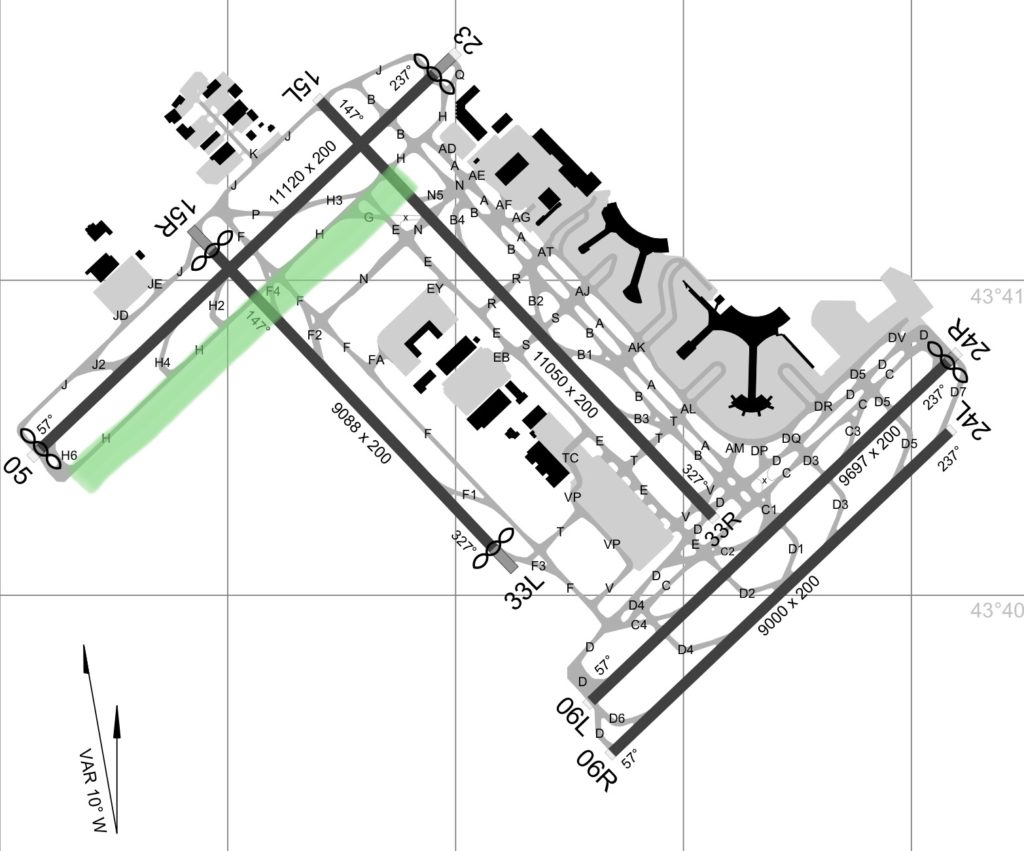Should Pearson build a sixth runway, or is it better for regional capacity to instead build Pickering airport? Today Pearson airport has five runways but can only use two of them for landings at once. This is due to their close proximity to each other and Transport Canada safety standards. The GTAA ,which runs only Pearson airport, is opposed to allowing the construction of a new airport in Pickering. Is it time for it to relent and allow competition?
Due to capacity and noise abatement requirements, Pearsons three east west runways, 05-23, 06-24L, and 06-24R are used by 19 out of 20 aircraft. Due to the cramped airside layout, the 06-24 runway pair are to close to each other to allow for simultaneous landings. The two North/South runways, 15-33L and 15-33R, cannot be used at the same time as the East/West set.
During a presentation and Q&A, on dec 6th 2017, GTAA VP Hillary Marshall’s made repeated reference to a long discounted plan to build another runway as a way to increase capacity. The idea would be to pair runway 05-23 with a parallel runway just like the other East/ West pair, 06-24 left and right. Under ideal conditions this would allow the 05-23 runway pair to handle the same number of movements as the 06-24 runway pair.

Unfortunately, as the paired runways are too close to each other to enable simultaneous landings, it would only add a dozen movements an hour according to the GTAAs new master plan. To quote chapter 6, page 46, of the 2017 draft master plan concerning maximum hourly aircraft movements in non instrument conditions, “48 on Runway 05-23 and 60 on closely spaced parallel runways”. That is a difference of only 12 movements an hour. Given the billion dollar cost and disruption of building another runway at Pearson this appears to be a nonstarter. So why did a VP at the GTAA refer to it as a possiblity?
Thanks to the expected growth in aircraft movements, Pearson is now planning to be 100% full 17 hours a day at some point in the near future. In order to best manage this congestion and to reduce the fragility this creates to external forces such as weather, a sixth runway would help improve the airports robustness. That the GTAA is even considering this idea, despite it huge cost, just for a handful of extra movements and to improve snow clearing operations, shows how serious Pearson capacity issue really is.
Although the GTAA would not be involved, building that same runway in Pickering would be a far better idea. Not only would it provide four times the capacity increase, 48 movements an hour versus 12, it could relieve the pressure building at Pearson. With a greenfield design, free of the baggage of rebuilding existing infrastructure, and the cost and worries of disrupting traffic at Pearson, building a runway at a new airport in Pickering is also expected to be much cheaper.
Maybe their plan is to stagger the approachs such that 2 aircraft can land in close succession. Given the ever increasing demand I can’t understand why they would pull support from Buttonville in the first place. Where is that excess capacity going in the meantime.
A good question, the short answer is No and can be found in CARs ( Canadian Air regulations ) Standard 821 – Canadian Domestic Air Traffic Control Separation. Here you will find the safety standards for aircraft separation on arrivals and departure that air traffic control and pilots are required to know and follow.
The exact standards can be found here:
https://www.tc.gc.ca/eng/civilaviation/regserv/cars/part8-standards-821-531.htm#821_1_1_0
It defines what is and is not possible for different sizes ( wake categories) of aircraft.
The long answer is, as the traffic mix allows (for example a heavy 747 following a beach 1900 light twin ), and as long as a pilot waivers the separation (he is comfortable, no check pilot on his shoulder, wink wink), the weather is right to move the wake ( visual conditions, a stiff crosswind for the south), you can exceed 60 an hour combined on two runways 24l&R. Pearson has in the past compressed the arrivals and departure for brief peak times to achieved over 60 movements an hour on 24L and 24R. But this has never been done consistently.
The reality is that even 60 an hour is hard to achieve with the current traffic mix or normal weather conditions while adhering to the existing safety standards. The new master plan is planning on great weather, a smoothing of aircraft types and cooperation of pilots and carriers just to do 60 an hour. The moment you have a windy day, or low ceiling , or a bit of rain or snow/ice, 45-50 an hour is more realistic (25 landings on 24L, 25 takeoffs on 24R) is more realistic all weather goal.